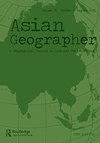粮食安全评估的城乡联系维度:印度尼西亚案例研究
IF 2.2
Q2 GEOGRAPHY
引用次数: 1
摘要
摘要本研究重点对两个主要领域的当前理论进行了文献综述:粮食安全和城乡联系。然后,它批判性地评估了这两者之间的关系。它审查了世界粮食计划署编制的《粮食安全脆弱性图集》在多大程度上考虑到了城乡联系层面。基于从印度尼西亚中爪哇省两个地方政府获得的经验数据,探讨了对粮食安全支柱产生重大影响的农村和城市特征之间的联系和差异。这项研究表明,尽管指南中没有明确提及城乡联系的概念,但印度尼西亚的《粮食安全脆弱性图集》编制指南中已纳入了城乡联系的层面。然而,由于缺乏数据准备,在市政府和县政府层面翻译此类指南存在问题。与此同时,试图修改粮食安全指标以适应数据的可用性,在某种程度上与城乡联系的概念不兼容。本文章由计算机程序翻译,如有差异,请以英文原文为准。
The dimension of rural-urban linkage of food security assessment: an Indonesian case study
ABSTRACT This study puts emphasis on a literature review of current theoretical strands in two major fields: food security and rural-urban linkage. It then critically evaluates the relation between these two. It examines the extent to which the preparation of the Food Security Vulnerability Atlas developed by the World Food Programme considers the rural-urban linkage dimension. The linkage and differences between rural and urban characteristics that significantly affect the pillars of food security are explored based on empirical data obtained from two local governments in Central Java Province, Indonesia. This study shows that the dimension of rural-urban linkage has been included in the Food Security Vulnerability Atlas preparation guideline in Indonesia, although the notion of rural-urban linkage is not explicitly mentioned in the guideline. However, translation of such guideline at the municipality and regency government levels is problematic due to a lack of data readiness. Meanwhile, attempts to modify food security indicators to adapt to data availability are somehow not compatible with the notion of rural-urban linkage.
求助全文
通过发布文献求助,成功后即可免费获取论文全文。
去求助
来源期刊

Asian Geographer
GEOGRAPHY-
CiteScore
3.30
自引率
0.00%
发文量
7
期刊介绍:
Asian Geographer disseminates knowledge about geographical problems and issues focusing on Asia and the Pacific Rim. Papers dealing with other regions should have a linkage to Asia and the Pacific Rim. Original and timely articles dealing with any field of physical or human geographical inquiries and methodologies will be considered for publication. We welcome, for example, submissions on people-environment interactions, urban and regional development, transport and large infrastructure, migration, natural disasters and their management, environment and energy issues. While the focus of the journal is placed on original research articles, review papers as well as viewpoints and research notes under the category of “Asian Geography in Brief” are also considered. Review papers should critically and constructively analyse the current state of understanding on geographical and planning topics in Asia. The ‘Asian Geography in Brief’ section welcomes submissions of applied geographical and planning research about Asia. The section aims to showcase (1) the diverse geography and planning of Asia; and (2) the diverse geographical and planning research about Asia. The journal will also publish special issues on particular themes or areas. Book reviews can be included from time to time.
 求助内容:
求助内容: 应助结果提醒方式:
应助结果提醒方式:


